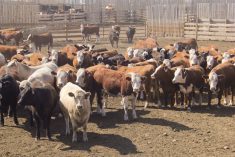Chicago | Reuters — Chicago Mercantile Exchange live cattle closed higher on Friday, helped by short-covering and positioning before the U.S. Department of Agriculture’s monthly Cattle on Feed report on Friday at 2 p.m. CT, said traders.
They said that with December futures slated to be the new lead month following October’s expiration, investors periodically sold December and simultaneously bought the February contract.
October live cattle, which will expire on Oct. 31, finished up 0.475 cent/lb., to 111.675 cents (all figures US$).
Most actively traded December closed 0.45 cent higher at 116.6 cents. February ended 0.625 cent higher at 121.275, and above the 10-day moving average of 121.153 cents.
Read Also

U.S. livestock: Feeder cattle hit contract highs on tight supply
Chicago | Reuters – All Chicago Mercantile Exchange feeder cattle futures and most live cattle futures hit contract highs on…
Investors factored in what could be $110 to $111/cwt paid by packers for slaughter-ready, or cash, cattle in the U.S. Plains this week after sales conclude late on Friday, said traders and analysts. Cash cattle last week brought $111.
Packers resisted paying up for cattle, a move that in recent weeks reduced their margins. Near-term beef wholesale beef demand still face challenges during the rest of October Pork Month along with year-end holiday ham and turkey promotions.
USDA will issue the monthly cold storage report on Monday at 2 p.m. CDT that will include September total beef and pork inventories.
A survey of analysts, on average, projected last month’s total beef stocks at 500.2 million pounds and 596 million for pork.
Weaker corn prices and live cattle futures gains supported CME live cattle.
October ended up 0.475 cent/lb., to 153.625 cents.
Hog futures up third straight day
CME lean hog futures rose for a third day in a row on short-covering and Friday morning’s wholesale pork price rebound, said traders.
They said CME hogs garnered more support from buy stops and speculative buying, despite futures’ premiums to cash prices that may be about to top out as packer margins dwindle.
“It’s been hard,” said Rosenthal Collins broker James Burns regarding Friday’s conflicting market signals. “It feels like it really comes down to what packer is just paying up for hogs like crazy,” he said.
For almost three weeks established packing plants hiked hog bids to maintain market share after four new plants came online in recent months, said traders and analysts.
They expect wholesale pork values to fluctuate over the next couple of weeks as Pork Month in October winds down and supermarkets consider advertising beef in November.
— Theopolis Waters reports on livestock markets for Reuters from Chicago.
















